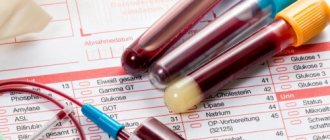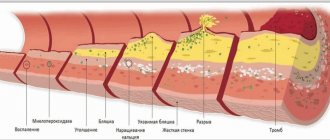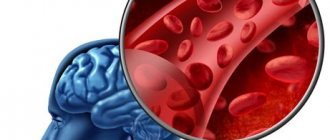Decoding the results is the competence of a pediatrician, therapist or specialist, since it is important not only to analyze the numbers, but also to compare deviations from the norms of different indicators, to compare the information obtained during examination and history taking. To have an overview and be prepared when you see your doctor, learn what blood elements are tested in the laboratory, how to interpret the results, and what abnormalities may mean.
What indicators does the blood test contain?
Donating blood for testing is necessary during planned hospitalization, to assess the effectiveness of the therapy, and during pregnancy. To make an accurate diagnosis and prescribe treatment, the doctor always prescribes a general blood test. Material for research is taken from a finger or from a vein. The second option is preferable, since venous blood more accurately shows the level of hemoglobin and red blood cells.
First of all, red blood cells, white blood cells and platelets are analyzed, as well as:
- Hemoglobin level.
- Erythrocyte indices.
- Hematocrit level.
- Reticulocyte count.
Additionally, the erythrocyte sedimentation rate (ESR), color and blood clotting period are determined.
An extended study involves indicating the leukocyte formula, including the count of eosinophils, lymphocytes, monocytes, band and segmented neutrophils.
Preparing for analysis
A general blood test requires proper preparation. Before the study, it is important to adhere to the following rules:
- Blood must be donated on an empty stomach. Otherwise, nutrients (entered into the blood) may interfere with the correct determination of the blood formula.
- You should refrain from smoking for several hours before donating blood.
- It is advisable to abstain from alcohol 2-3 days before the planned analysis.
- The day before donating blood, avoid physical and emotional stress.
- The day before you should refrain from taking medications (if possible). If you cannot refuse the medication, you should notify your doctor.
Basophils and estrogens
It has been established that drugs containing estrogen increase the number of basophils. Therefore, if you are taking such drugs, tell your doctor. When deciphering the analysis for basophil content, the specialist will make an adjustment for this.
Interpretation and normal values of the main blood test parameters
| How is it designated? | What does it mean | Norm for women | Norm for men |
| R.B.C. | Red blood cells | 3,5-4,5 | 4,0-5,5 |
| WBC | Leukocytes | 4-9 | |
| PLT | Platelets | 180-320 | |
| HGB | Hemoglobin | 120-140 | 130-170 |
| MCV | Average erythrocyte volume | 82-98 | 81-95 |
| MCH | Average HGB level in erythrocyte | 26-32 | |
| MCHC | Average concentration of red blood cells in HGB (%) | 31-38 | |
| HCT | Hematocrit (in%) | 35-44 | 40-50 |
| RET | Reticulocytes (%) | 0,2-1 | |
| ESR | ESR (mm/h) | 2-15 | 1-10 |
| CPU | Color | 0,85-1,05 | |
Norms of basophils in the blood
The normal level of basophils in the blood (BASO) changes in children under 2 years of age.
In adults (men and women), the norm is 0.5-1% (Table 1). Table 1. Norm of basophils (BASO) in the blood by age and gender
| Newborns | Up to 1 month | One year old children | Children under 2 years old | Adults (men, women) | |
| Basophil level (BASO) | 0,75% | 0,5% | 0,6% | 0,7% | 0,5-1% |
Causes of elevated basophils
A high level of basophils is called basophilia. This condition can be dictated by both pathological and physiological reasons. Let's take a closer look at them.
Physiological causes of increased basophils:
- Menstruation and ovulation, when there is a high level of female sex hormones in the blood. As mentioned above, estrogens increase the level of basophils.
- The recovery period after an infection (basophil levels may be elevated for several days or weeks).
- When exposed to small doses of radiation. Often, an increased number of basophils is observed among radiologists or laboratory technicians.
- After taking contraceptives containing estrogen.
Pathological causes of high basophil content:
- allergic reactions²;
- bone marrow diseases³;
- thyroid deficiency (hypothyroidism);
- inflammatory diseases;
- ulcerative colitis;
- autoimmune diseases (eg rheumatoid arthritis4);
- asthma;
- infectious pathologies (viral, bacterial, fungal, parasitic).
Basophilia in children can be caused by other reasons, including:
- poisoning;
- parasites (worms);
- insect bites;
- anemia (iron deficiency, hemolytic);
- allergy;
- nephrotic syndrome;
- sinusitis;
- blood diseases;
- endocrine diseases (usually thyroid diseases);
- gastrointestinal pathologies.
Basophils are counted both manually and under a microscope. Photo: gstockstudio / freepik.com
Causes of low basophils
A decreased level of basophils is called basopenia. This condition is not dangerous to health. It can occur, for example, when basophils migrate from the blood to inflammatory foci. If the basophil has released its granules, then it is already considered inactive. Such cells are not taken into account when counting. For doctors, “empty” basophils serve as an additional diagnostic criterion, which indicates the presence of an inflammatory reaction.
Common causes of a pathological decrease in basophils include:
- Hyperthyroidism is an overactive thyroid gland.
- Urticaria is an allergic disease that manifests itself as a skin rash.
- Lupus is an autoimmune pathology in which foci of inflammation form in the joints, skin, heart and brain.
- Taking corticosteroid drugs. If you are taking such medications, please notify your doctor so that the results can be corrected.
- Depression. The mechanism of the decrease in basophils in depression is unknown, but the fact itself has been established.
- Smoking – contributes to a slight decrease in the level of basophils5. After giving up the bad habit, basophils rise again to normal levels.
Smoking reduces basophil levels. Photo: freepik.com
What deviations in the UAC may mean
For diagnosis, both a current blood test and previous studies are important to track changes. Let's consider what deviations in indicators can mean:
- Red blood cells. Exceeding the value is accompanied by insufficient oxygen supply, dehydration, acquired heart disease, and impaired adrenal function. The level may be lower than normal due to blood loss, iron deficiency anemia, in the second half of pregnancy, and with chronic infectious diseases.
- Leukocytes. Leukocytosis (exceeding the norm) can be caused by physiological characteristics or pathology. In the first case, the causes are: pregnancy, intense physical/psycho-emotional overload, hypothermia/overheating. Inflammatory and oncological diseases, poisoning and allergic reactions are manifested by pathological leukocytosis. With leukemia, bone marrow hypoplasia, liver damage, measles, lymphogranulomatosis, autoimmune diseases, a decrease in leukocytes will be detected.
- Platelets. The amount decreases with leukemia, AIDS, poisoning, bone marrow damage, prolonged therapy with hormones or antibiotics. The indicator goes beyond the normal range with inflammation of the rectal mucosa, osteomyelitis, joint diseases, cancerous lesions, and in the postoperative period.
- Hemoglobin level. Exceeding the norm occurs against the background of an increased platelet count, impaired blood clotting function, after a gastrointestinal disorder, or with an overdose of medications for anemia. Low HGB gives the right to suspect the presence of internal bleeding, kidney dysfunction, malignant neoplasms, and bone marrow damage.
- Erythrocyte indices (MCV, MCH, MCHC). The indicators give an idea of the state of red blood cells and their functionality. MCV is the average volume of one red blood cell; it increases with diseases of the liver and hematopoietic system, lack of folic acid and vitamin B12. Decreased in some types of anemia, hyperthyroidism, hemoglobinopathy. MCH shows the average hemoglobin content in one red blood cell. Analogous to color index. MCHC – average concentration of red blood pigment. The interpretation is carried out taking into account other indices.
- Hematocrit level. Allows you to assess the severity of anemia associated with iron deficiency. Exceeding the norm indicates dehydration, extensive burns, and inflammation of the peritoneum. A low figure gives the right to suspect pathologies of the heart and vascular system, kidney disease, blood disease, extensive blood loss, malaria, and poisoning.
- Reticulocyte count. Exceeding the norm is observed in case of blood loss, poisoning, taking certain medications, during the recovery period after treatment of cancer, diseases of the hematopoietic system, metastases in the bone marrow. A decrease in the number of young red blood cells is caused by: anemia, kidney disease, chronic infections, bone marrow tumors, blood pathologies, myxedema of the thyroid gland, chemotherapy, deficiency of folic acid and vitamin B12.
- ESR. Decreases in heart pathologies, joint diseases, anaphylactic shock. Exceeding the norm is observed during pregnancy, anemia, severe poisoning, exacerbations of chronic diseases, and inflammatory processes in the body.
- Color. Hyperchromia (exceeding the norm) indicates a deficiency of cyanocobalamin, possible polyps in the stomach, various malignant tumors, and a lack of vitamin B9. Hypochromia (decreased color index) indicates anemia or lead poisoning. With normochromia, the doctor looks at the values of other, more informative indicators.
Interpretation of a general blood test
Below are the most basic indicators of the KBC, their functions in the body, and the reasons for deviations upward or downward.
Red blood cells
These are small elastic cells containing hemoglobin in their cytoplasm. Due to their elasticity, they easily pass through vessels of any caliber. They are produced in the bone marrow, the viability of one cell is about 3-4 months.
Red blood cells perform the following function: they carry oxygen from the lungs to all human tissues and organs, and on the way back from the tissues to the lungs they bring carbon dioxide. All this happens by adding gases to the hemoglobin of the red blood cell.
The norm of red blood cells when deciphering tests is on average from 3.8 to 5.0 1012/l
- An increase in red blood cells in a general blood test is possible with dehydration due to vomiting and diarrhea, diseases of the blood system (erythremia, Vaquez disease), cardiac and respiratory failure.
- their reduction can occur with blood loss, leukemia and lymphomas, congenital hematopoietic defects, hemolytic anemia, oncology, insufficient intake of protein, iron and vitamins.
It should be remembered that the norm of red blood cells, as well as other indicators, may differ in different laboratories. In which, moreover, errors are not excluded. Therefore, a borderline result does not always indicate a serious illness.
Hemoglobin
Hemoglobin is an iron-containing protein found in red blood cells. It is due to this that the function of gas exchange between the lung tissue and all cells of the body is performed. A deviation in hemoglobin levels from the norm can cause a person to feel unwell, weak, and easily fatigued. This is due to a lack of oxygen in organs, including the brain.
The normal hemoglobin content in a general blood test is on average 120-160 g/l, depending on the gender and age of the subject.
- An increase in hemoglobin can occur due to dehydration due to diabetes mellitus, vomiting and diarrhea, due to heart failure, overdose of diuretics, pulmonary failure, heart defects, diseases of the blood and urinary system.
- A decrease in hemoglobin in a general blood test is possible with anemia of various origins and other blood diseases, blood loss, insufficient intake of protein, vitamins, and iron
Leukocytes
These are white blood cells synthesized in the bone marrow. They perform the most important defense function in the body, aimed at foreign objects, infections, and foreign protein molecules. They are also able to dissolve damaged body tissue, which is one of the stages of inflammation. The viability of these cells varies from several hours to several years.
The norm of leukocytes in a general blood test corresponds to 4.0-9.0 109/l.
- An increase in leukocytes in the CBC is possible due to physiological errors (pregnancy, donating blood after meals, heavy physical activity, after vaccinations), inflammatory processes of a systemic or local nature, extensive injuries and burns, active autoimmune diseases, in the postoperative period, with oncology, leukemias and leukemias.
- If, when reading a blood test, leukocytes are reduced, the presence of viral infections, systemic autoimmune diseases, leukemia, radiation sickness, and hypovitaminosis is acceptable. Taking cytostatics and steroids may also affect this.
Color index
The color index (CI) is determined by a calculation method using a special formula. It shows the average concentration of hemoglobin protein (Hb) in one red blood cell.
Normally, the CPU is 0.8-1.0, without units of measurement.
- Its increase may indicate the presence of hyperchromic anemia (vitamin D deficiency).
- A decrease is possible in iron deficiency anemia, posthemorrhagic anemia, leukemia and lymphoma, and chronic organ diseases.
Hematocrit
This is an indicator reflecting the ratio of blood cells (leukocytes, erythrocytes, platelets) to the total blood volume. The analysis is carried out by centrifugation or using analyzers.
Normally, the hematocrit is on average 35-50%.
- An increase may indicate erythremia, respiratory failure, heart failure, dehydration due to diabetes mellitus and diabetes insipidus, diarrhea and vomiting.
- A decrease in hematocrit may be due to anemia, erythrocytopenia, renal failure, pregnancy (third trimester).
Reticulocytes
These are the precursors of red blood cells, their intermediate form. They perform the function of gas exchange, just like red blood cells, but with less efficiency. In a healthy person, reticulocytes, when deciphered, make up 0.2-1.2% of the total number of red blood cells.
- They may be increased during post-hemorrhagic restoration of hematopoiesis, when moving to a mountainous area or when treating anemia.
- Reticulocytes in the general blood test decrease with reticulocytopenia (slow hematopoiesis in the bone marrow, leading to anemia).
Platelets
These are small, flat blood cells that have no color. They perform several important functions - they participate in blood clotting, form platelet thrombus, regulate the tone of the vascular wall, and nourish capillaries.
In a general blood test, the normal platelet count is 180-320 109/l.
- An increase in platelets when deciphering the analysis is possible during splenectomy (removal of the spleen), exacerbation of chronic autoimmune diseases, anemia of various origins, inflammatory processes, in the postoperative period, the third trimester of pregnancy, in oncology, erythremia.
- Platelets in the CBC decrease in hemophilia, drug-induced thrombocytopenia, systemic lupus erythematosus, viral and bacterial infections, aplastic anemia, Evans syndrome, autoimmune thrombocytopenic purpura, and renal vein thrombosis.
ESR
Erythrocyte sedimentation rate (ESR) is an indicator calculated during a laboratory test. Under the influence of anticoagulants, the erythrocyte sedimentation time is calculated, which depends on the protein composition of the plasma.
This is a highly sensitive indicator; normally it averages from 1 to 15 mm per hour.
- It increases during physiological conditions (pregnancy, menstruation), during infectious diseases, malignant neoplasms, systemic autoimmune diseases, kidney diseases, in the postoperative period, during injuries and burns.
- Decreased in astheno-neurotic syndrome, recovery from infection, cachexia, long-term use of glucocorticoids, blood clotting disorders, high concentrations of glucose in the blood, traumatic brain injury, use of NSAIDs, immunosuppressants, antibiotics.
Neutrophils
This is the largest subtype of leukocytes, which, depending on the maturity of the cells, is divided into the following groups - young neutrophils, band neutrophils and segmented neutrophils.
They perform an antimicrobial function, are capable of phagocytosis, and participate in the inflammatory response.
The normal range of neutrophils in a blood test is band 1-6%, segmented 47-67%.
- An increase in neutrophils when decoding a blood test is possible under physiological conditions (sun and temperature exposure, stress, pain, etc.), previous infections, bone marrow diseases, oncology, taking certain medications, ketoacidosis, poisoning with poisons and alcohol, and parasitosis , allergies, hyperglycemia.
- They decrease in the state after chemotherapy, with HIV/AIDS, aplastic anemia, long-term infectious disease, exposure to radiation, deficiency of vitamin B12 and folic acid.
Lymphocytes
This is also a subtype of leukocytes, presented in the form of T lymphocytes, B lymphocytes, K and NK lymphocytes.
All of them participate in acquired immunity, synthesize antibodies, destroy not only foreign, but also their own pathological cells (oncological).
The norm of lymphocytes when deciphered in the CBC is 18-40%
- An increase in the general blood test can occur with viral infections (mononucleosis, viral hepatitis and others), toxoplamosis, blood diseases (chronic and acute lymphocytic leukemia, lymphoma, leukemia), with arsenic, lead poisoning, taking levodopa, narcotic painkillers.
- Lymphocytes decrease in tuberculosis, HIV, blood diseases (lymphogranulomatosis, aplastic anemia), end-stage renal failure, cancer in the terminal stage and during treatment with radiotherapy and chemotherapy, taking glucocorticoids.
Monocytes
This is a type of the largest leukocytes, also synthesized in the bone marrow. They are able to phagocytose (absorb) viruses, bacteria, tumor and parasitic cells. Regulate hematopoietic function and participate in blood clotting.
The normal blood test for monocyte content is 3-11%.
- an increase in monocytes when deciphered indicates viral, bacterial (tuberculosis, syphilis, brucellosis), fungal and parasitic infections, inflammation in the regeneration stage, systemic autoimmune diseases (systemic lupus erythematosus, rheumatoid arthritis), leukemia.
- a decrease in monocytes in a blood test is possible during purulent-inflammatory processes, aplastic anemia, in the postoperative or postpartum period, and when taking steroids.
How to reduce or increase basophils
The physiological causes of basophilia are short-lived and disappear after discontinuation of the factor that increases basophils. Thus, the abolition of hormonal contraceptives and avoidance of radiation bring basophils back to normal in a short time.
As for pathological basophilia, BASO levels can be normalized by starting treatment for the underlying disease. This includes antiallergic therapy, deworming (elimination of worms), treatment of inflammatory diseases and blood diseases.
To reduce the level of basophils in basophilia, it is also recommended to saturate the body with a sufficient amount of vitamin B12 (cyanocobalamin) and iron. These components are found in meat, offal, eggs, fish and dairy products. In some cases, the doctor prescribes preparative vitamin and mineral complexes with iron and B12.









